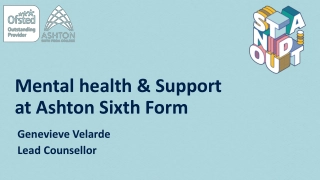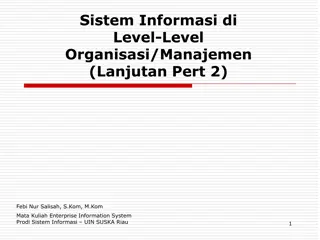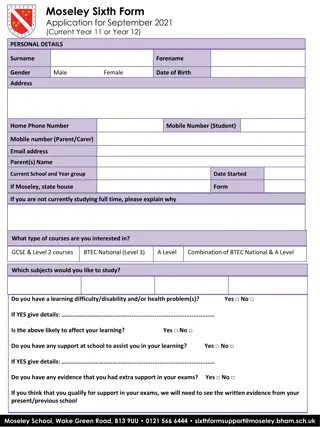Changing Systems for Success in Sixth Form at JCoSS
As you prepare to enter sixth form at JCoSS, it's vital to consider personalization and implementing systems for a fantastic year. Understand personalization, its role in health and social care, and the importance of a person-centered approach. The unit overview covers key learning objectives, and assessment details are provided to guide you towards exam success.
Download Presentation

Please find below an Image/Link to download the presentation.
The content on the website is provided AS IS for your information and personal use only. It may not be sold, licensed, or shared on other websites without obtaining consent from the author.If you encounter any issues during the download, it is possible that the publisher has removed the file from their server.
You are allowed to download the files provided on this website for personal or commercial use, subject to the condition that they are used lawfully. All files are the property of their respective owners.
The content on the website is provided AS IS for your information and personal use only. It may not be sold, licensed, or shared on other websites without obtaining consent from the author.
E N D
Presentation Transcript
These are definitely strange times, and what we think will happen can sometimes dramatically change. But what I would like you to think about is how can YOU change, what systems do you need to put in place to ensure that you have a fantastic year as you enter sixth form next year at JCoSS. It will be tough, challenging but rewarding and in this unit we will work together to ensure that you achieve and overcome many challenges.
What is personalisation? What is personalisation? Write down what you think personalisation means? Write down what you think personalisation means in a health and social care setting? Can you identify who is mainly involved in personalisation? KEEP HOLD OF THESE NOTES, YOU WILL NEED THEM LATER
What is personalisation? CLICK HERE FOR VIDEO
Personalisation in a nutshell Meeting the individuals needs and wishes in regards to care Putting the individual at the centre of the care this is called person- centred care Giving the individual more choice and control Working with various authorities to provide more person-centred care, such as government and local authorities Allowing the individual to make decisions about their care Recognising individual's strengths, wishes and preferences
Unit Overview Unit Overview Four Learning Units: An overview Click on each learning objective to learn more LO1: What is personalisation LO2: Understand what is meant by a person-centred approach to care LO3: Understand methods used to implement a person-centred approach LO4: Know how to plan and conduct review meetings using a person- centred approach
Assessment Assessment 1 hour 30 minute written exam worth 60 marks Different style of question, which include short answer questions and longer, extended questions. DON T PANIC!!! You will be supported and guided all the way towards your exams!
Make sure you know your command verbs In your exam you will be asked question using command verbs. It is important you know these, because you will be expected to answer in the in these in the correct manner. For example, the command verb explain would require you to provide an example within a health and social care setting.
Personalisation in more detail Personalisation is defined by the department of health as follows; every person who received support, whether by statutory services or funded by themselves, will have choice and control over the shape of that support in all care settings. However, this definition is limited as it does not imply that individual receiving support will be at the centre of the process. Personalisation means recognising that the person has individual strengths, preferences, whishes' and aspirations. It means putting them at the centre of the process by identifying their needs and supporting them to make choices about the services they want so they can live the way they want to. Write down the definition and identify what you feel are the key words within the paragraph. Give reasoning as to why you picked them and how different are they to your original notes?
What is the main thing we need to survive in What is the main thing we need to survive in the modern world? the modern world?
Personalisation is more than just about money, e.g. Personalisation is more than just about money, e.g. access to services, transport, leisure, strengthening access to services, transport, leisure, strengthening communities. communities.
The implications for social care professionals, e.g. The implications for social care professionals, e.g. their aim is to enable and empower individuals, not their aim is to enable and empower individuals, not fix their problems . fix their problems .
- Important so that indivudals make their own choice Let s the individual be in control - Allows the individual to feel that they re part of the decision process Addressing needs - Control Empowerment PERSONILSATION TO AN INDIVIDUAL MEANS Meeting aspirations Independence Participation Preferences Choice For each section identify as many points for why they may be important for an individual within a health and social care setting . Control has already been filled in for you
LO1 Understand personalisation in health and LO1 Understand personalisation in health and social care social care 1.1 Definition of personalisation (e.g. people receiving support, either statutory or self- funded, have choice and control over that support in all care settings) (DEFINE) 1.2 Key features of personalisation, i.e. (DESCRIBE) Direct payments Managed accounts Coproduction (e.g. citizenship model) Choice and control (e.g. where and how care is provided, employing personal assistants) Self-assessment of needs Changing role of professionals (e.g. the individual knows what is best for themselves, not the professional) CLICK HERE TO GO BACK TO THE MAIN MENU
LO1 Understand personalisation in health and LO1 Understand personalisation in health and social care social care 1.3 Benefits of personalisation to an individual (e.g. individuals gain and maintain control, able to remain in own home whilst receiving care, inclusion within the community, improved information and guidance) (ANALYSE & EVALUATE) 1.4 Impacts of personalisation, i.e. (ANALYSE & EVALUATE) positive (e.g. direct payment for care allowing rapid access to services, inclusion within communities, preventing isolation, remaining in own home where familiarity and sense of belonging add to quality of life, access to information and guidance allowing better choices, new opportunities) challenges (e.g. care limited to the prescribed budget, availability and access to some services may be restricted in some areas) 1.5 Legislation underpinning personalisation, i.e. (IDENTIFY) Health and Social Care Act 2012 Local Authority Circular (DH) 2008 Personalisation Guidance. The Care Act 2014 Children and Families Act 2014
LO1 Understand personalisation in health and LO1 Understand personalisation in health and social care social care 1.6 Role of local authority, i.e. (DESCRIBE) assessment, i.e. Education, Health and Care Plan (EHCP) Fair Access to Care budgets (e.g. individual, direct payments) housing (e.g. choice of residence, housing adaptations, meeting housing needs) The Care Act (e.g. removal of geographical barriers) decentralisation and commissioning (e.g. outsourcing services, promoting greater range of choice)
LO2 Understand what is meant by a person LO2 Understand what is meant by a person- -centred approach to care approach to care centred 2.1 Person-centred approach, i.e. a balance between what is important to and what is important for a person enhancing voice, choice and control clarification of roles and responsibilities
LO2 Understand what is meant by a person LO2 Understand what is meant by a person- -centred approach to care approach to care centred 2.2 Principles of a person-centred approach and how they support person-centred care, i.e. independence and rights (e.g. to live life the way they want to, to be employed, to form meaningful relationships) co-production, choice and control (e.g. to be treated as an equal partner in decision making about their care, to be able to make decisions about their life/care, to have more of what is important to them) inclusive and competent communities (e.g. to be able to participate in community activities, to volunteer, to feel they belong
LO2 Understand what is meant by a person LO2 Understand what is meant by a person- -centred approach to care approach to care centred 2.3 Current context of the person-centred approach, i.e. the policy landscape, i.e. personalisation personal budgets role of a person-centred approach in achieving good practice in the delivery of care services 2.4 Historic overview, i.e. institutional history of public services disability rights movement and links to person-centred approach
LO2 Understand what is meant by a person LO2 Understand what is meant by a person- -centred approach to care approach to care centred 2.5 Challenges to adopting a person-centred approach, i.e. resistance to change institutional history of public services institutions promoting a medical model of disability lack of staff training communication barriers respecting choice when alternatives may promote better health or wellbeing focusing on deficits rather than capacities lack of clarity over roles and responsibilities
LO2 Understand what is meant by a person LO2 Understand what is meant by a person- -centred approach to care approach to care centred 2.6 Methods for overcoming challenges, i.e. values-based recruitment staff training regular review of support provided recognising when provision is not person-centred and taking action to rectify modelling behaviour
LO3 Understand methods used to implement a LO3 Understand methods used to implement a person person- -centred approach centred approach 3.1 Tools to find out what is important to/for a person i.e. (EVALUATE & ANALYSE) good days/bad days (e.g. describe a typical day, what would it take to have more good days and fewer bad days?) routines (e.g. daily, weekly, celebrations) top tips (e.g. two minutes to share what you know about an individual and the best way to support them) relationship circles (e.g. who they know, how they know them, who knows who, how networks can support) one page profiles (e.g. positive qualities, strengths and talents an individual has, what is important to the individual, important people in their life, hobbies, routines)
LO3 Understand methods used to implement a LO3 Understand methods used to implement a person person- -centred approach centred approach 3.2 Tools that enhance voice, choice and control, i.e. (EVALUATE & ANALYSE) communication charts decision-making charts building of effective relationships with individuals who require care or support 3.3 Tools to clarify roles and responsibilities in the care relationship, i.e. (EVALUATE & ANALYSE) doughnut chart
LO3 Understand methods used to implement a LO3 Understand methods used to implement a person person- -centred approach centred approach understand how the individual communicates their wishes and needs focus on the individual s capabilities and how they can best be supported to make decisions find out what is important to a person to have a good quality of life find out who is important in a person s life (e.g. clarify the roles and responsibilities of the network of people who are involved in the day- to-day life of the individual requiring care and support)
LO4 Know how to plan and conduct review LO4 Know how to plan and conduct review meetings using a person meetings using a person- -centred approach centred approach 4.1 Review meetings, i.e. (DESCRIBE & UNDERSTAND) the importance of reviews in health and social care (e.g. putting the individual at the centre of the meeting, builds and shares information collaboratively, generates actions) the purpose of review meetings (e.g. meeting changing needs, reviewing budget, ensuring care relationships are effective, to review the person-centred description)
LO4 Know how to plan and conduct review LO4 Know how to plan and conduct review meetings using a person meetings using a person- -centred approach centred approach 4.2 Planning and preparing for review meetings, i.e. (DESCRIBE & UNDERSTAND) understanding the role of the facilitator (e.g. supports the person whose review it is, considers how the person wants to be at the centre of the meeting) how the individual can be made to feel as comfortable as possible during the meeting, i.e. giving the individual choice over people present at the meeting (e.g. within statutory requirements) the timing of the meeting the location of meeting
LO4 Know how to plan and conduct review LO4 Know how to plan and conduct review meetings using a person meetings using a person- -centred approach centred approach 4.3 Conducting review meetings, i.e. (COMPARE & CONTRAST) person-centred tools used during the meeting ask appropriate questions (e.g. what is important to you now? What will be important in your future? What do you need to stay healthy, safe and well supported? What is working and not working from different perspectives) review budget generate actions consider solutions update records























